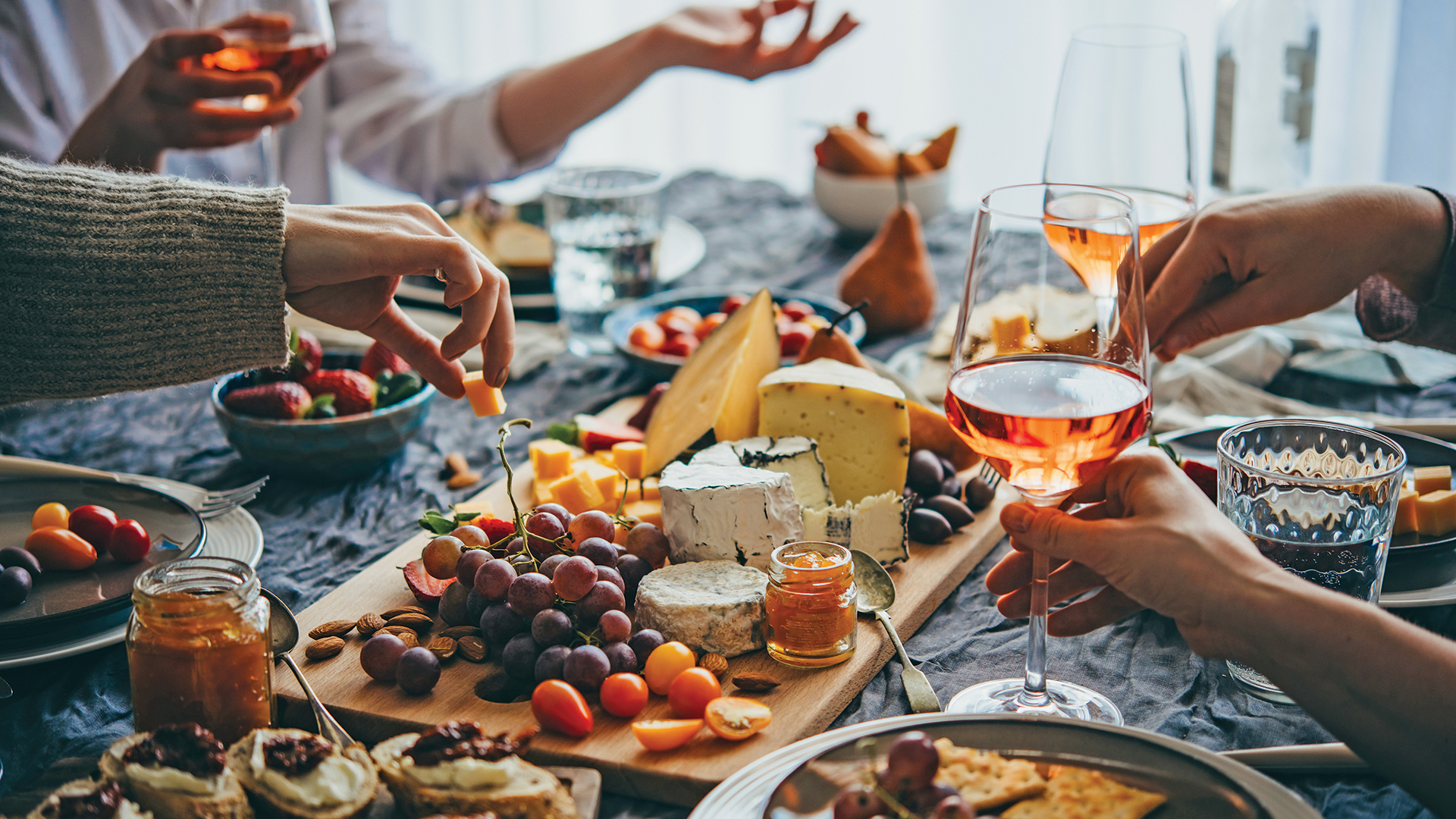The dishes we serve prior to the main course are designed to whet the appetite and set the tone for the meal. They occupy the mind and belly while guests wait for the main event that will satisfy their hunger to the fullest. So, when and where did this practice originate?
The ancient Romans and Greeks are depicted lounging with trays of fresh fruit, wine, olives, and cheese as part of their pre-prandial refreshments. Roman appetizers were so indispensable a part of a formal Roman dinner that a popular expression came to refer to the dinners as “from eggs to apples.” This refers to the fact that most Roman appetizers were based on eggs and would be considered a full-fledged course by itself in modern dining.
During the Renaissance (14th to 17th century), physicians recommended eating small morsels of salty meats prior to a meal in order to stimulate the appetite for food and drink. Wealthy Frenchmen picked at hors d’oeuvre (which translated from French means “outside the work”) throughout meals from the late seventeenth century through the mid-nineteenth centuries, when little plates ranged from oysters, stuffed eggs, slices of beef tongue or braised quails.
Soon after, Americans began to emulate the French tradition of hors of d’oeuvre (the plural is used only in English) when planning their dinners and offered small plates throughout the meal as a palate refresher, until the desserts were served.
Styles of service changed radically in the nineteenth century, evolving to the successive, multi course structure of formal contemporary meals. The role of hors d’oeuvres in the structure of meal changed as well. Although simple hors d’oeuvres such as olives, radishes, celery, and nuts remained on the table throughout the meal, by the late nineteenth century, more complicated hors d’oeuvres, sometimes called “dainty dishes” – such as small pastry cases filled with bits of meat in creamy sauce – had become a separate course after the soup was served.
The term “appetizers” seems to have appeared nearly simultaneously in England and America in the 1860s, simply to provide an Anglophone equivalent for the French hors d’oeuvre. By the 1890s, both appetizers and hors d’oeuvres appeared within the same menu. One writer in 1896 describes appetizers as “an optional first course preceding soup, that is set on the table prior to a party’s entering the dining room.” These appetizers were most often raw oysters or clams, but they might be small canapés, such as caviar on toast. The writer went on to say that celery, salted nuts and the like would fill the table throughout the meal, and the host would place these “various hors d’oeuvres within reach of each guest, these appetizers serving to fill in the time between course.”
So, whether you are dining out or in, choosing the perfect appetizer can set the tone for the rest of your meal. Featured here are some of our favorite appetizers from local restaurants for you to enjoy while out on the town or hosting in your home.
Crispy Kani Delight Sushi Cakes
with Sriracha Aioli from Zou 75
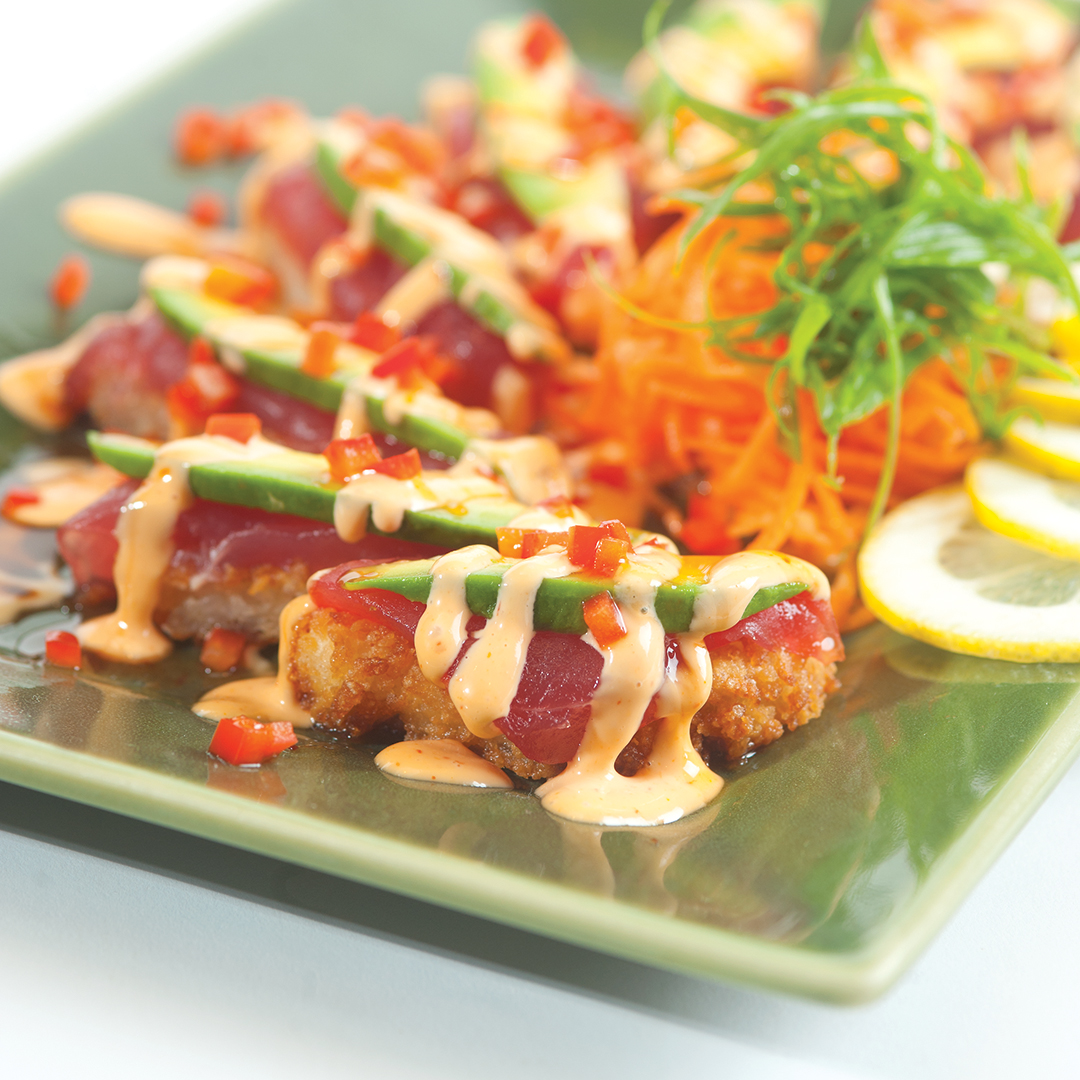
½ pound quality crab meat (preferably legs), cooked
½ pound sushi-grade ahi tuna, thinly sliced along the grain
1 cup sushi rice
1 ¼ cups water
pinch of salt
¾ cup panko breadcrumbs
¾ cup tempura batter, mixed with water
vegetable oil
½ avocado, thinly sliced
½ cup prepared sweet Asian chili sauce
½ red bell pepper, finely chopped
Sriracha Aioli
1 package (17 ounces) Japanese mayonnaise (preferably Kewpie)*
Sriracha (Asian chili sauce) to taste
1 tablespoon soy sauce
sriracha aioli. Blend the Japanese mayonnaise, Sriracha sauce and soy sauce in a mixing bowl to taste. To up the spiciness, add more Sriracha. Set aside.
preparation. Run cold water over rice rinse several times until water runs clear. Be sure to use Japanese short-grained white (japonica or sushi) rice. Drain the rice, and place in a sauce pot with water and salt. Over high heat, bring to a boil for one minute while stirring. Cover immediately, turn heat to low and cook rice for 10 to 15 minutes or until water is nearly gone. Turn heat off but keep lid in place and let steam for 10 minutes more.
Mix the cooked rice, crab meat, panko breadcrumbs and prepared tempura batter ingredients in medium bowl. Form mixture into cakes approximately one half-inch thick by one inch wide by three inches long. Place on wax paper.
Heat vegetable oil (about one inch deep) in medium saute pan. Carefully place cakes in pan, and fry until golden brown. Pat dry with paper towel.
final assembly and plating. Lay the ahi tuna and avocado at an angle over the sushi crab cakes, avocado first. Cut into one-inch long pieces and separate into a desired pattern. Drizzle the sweet Asian chili sauce over the pieces. Then drizzle with Sriracha aioli. Sprinkle red bell pepper over the top. Serve immediately, accompanied with wasabi, ginger and soy sauce.
*Japanese mayonnaise is made with sesame oil, rather than olive oil. It can be found in Asian specialty stores.
Red Curry Grilled Shrimp
with Sweet and Spicy Dipping Sauce from CKs
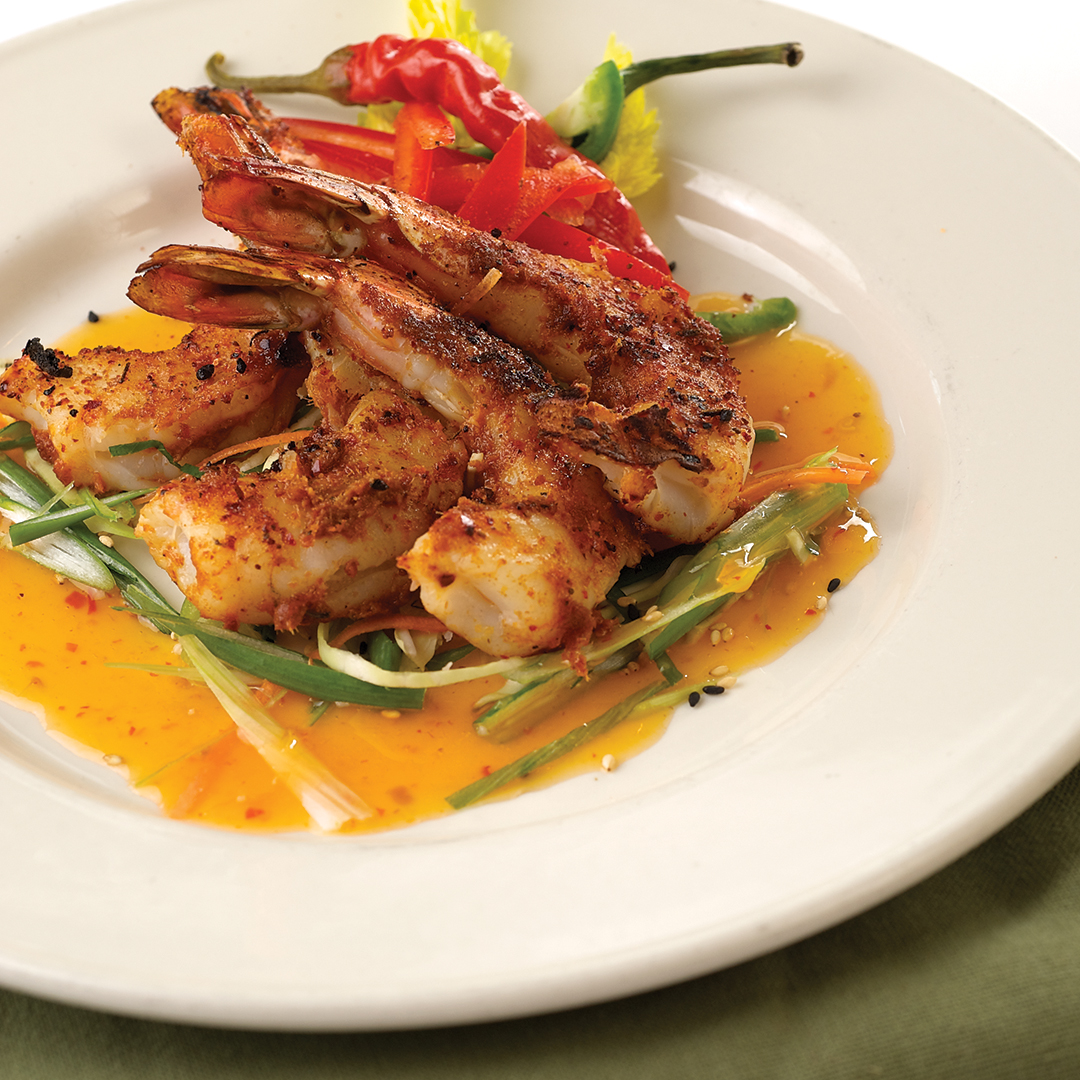
24 jumbo shrimp, peeled and deveined
2 tablespoons Thai red curry paste
1 tablespoon canola oil
12 bamboo skewers, soaked in water
Sweet and Spicy Dipping Sauce
1 cup sweet chili sauce
1 tablespoon lemongrass, thinly sliced
1 small serrano chili pepper, minced
1 lime, zested
½ cup lime juice (about 3 to 5 limes)
2 teaspoons fish sauce
1/3 cup rice vinegar
advance preparation. Peel and devein the shrimp and place in a bowl until ready to use. Whisk together red curry paste and canola oil in small mixing bowl. Double skewer shrimp through heads and tails with four shrimp per skewer arranged in a tight compact unit. Continue until all are double skewered. Lay arrangement on sheet pain. Brush the shrimp generously with the curry paste and canola oil marinade and set aside. This can be done the day before.
preparation. Preheat grill to 400°F. Remove shrimp from the refrigerator, then grill over medium heat for 5 to 7 minutes total, turning once.
sweet and spicy dipping sauce. Use a microplane to zest the lime. Combine the lime zest with the sweet chili sauce, sliced lemongrass, serrano chili pepper, lime juice, fish sauce, and rice vinegar in a blender. Store sauce in a glass jar or other container until ready to server. Refrigerate. This sauce keeps for a month.
final assembly and plating. Server with sweet and spicy dipping sauce.
Prosciutto Summer Rolls
with Tart Apple Sauce from Ketchum Grill
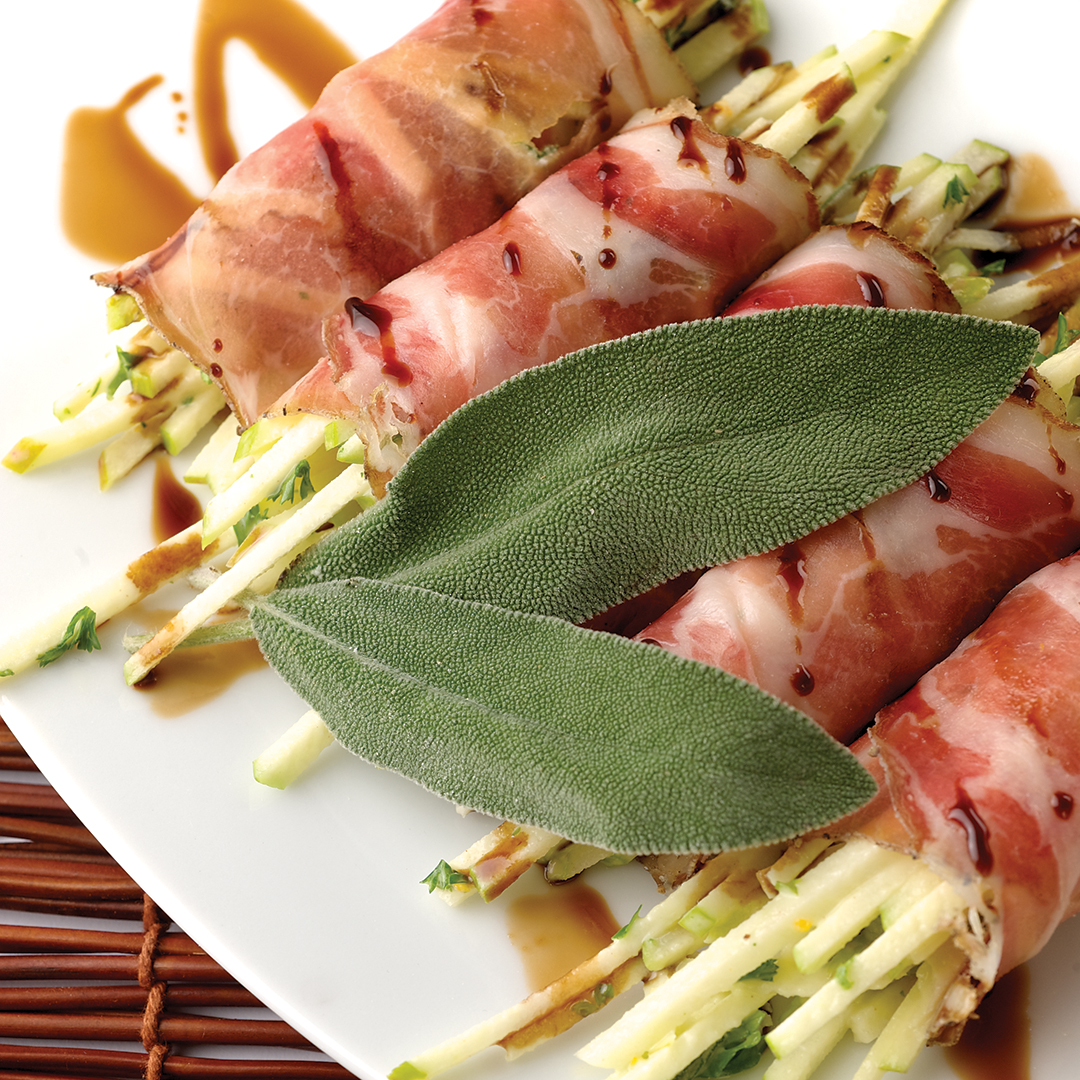
8-10 thin slices of prosciutto
2 tart green or tart red apples, julienned
¼ cup dried zante currants
½ orange, zested
freshly ground black pepper
green herbs, for garnish (optional)
Slaw Dressing
1 egg yolk
¼ cup lemon juice
¼ cup red wine vinegar
¼ cup Dijon mustard
2 cups pomace or pure olive oil
2 tablespoons honey
advance preparation. Prepare the slaw dressing by combining the egg yolk, lemon juice, red wine vinegar, Dijon mustard, and olive oil in a quart container. Using an immersion blender, emulsify the dressing by staring at the bottom and pulling the blender slowing upward to emulsify. Add the honey and blend again. This dressing is best if made in advance so the flavors can meld.
preparation. In a bowl, combine apple julienne, ½ cup of the prepared slaw dressing, the currants and long ribbons of orange zest from half of the orange. Add two turns of black pepper. Toss lightly to combine but carefully so as not to break the apples.
final assembly and plating. Assemble the summer rolls. High quality and very thinly sliced prosciutto will make this dish sublime. Lay out the pieces of prosciutto on a work table and divide the slaw between the slices. Place the slaw toward the end closest to you. Start by rolling away from you and roll each slice tightly around the slaw. Place on a serving platter. Garnish with fresh green herbs or a drizzle of balsamic vinegar reduction.
Classic Swiss Cheese Fondue
From The Roundhouse
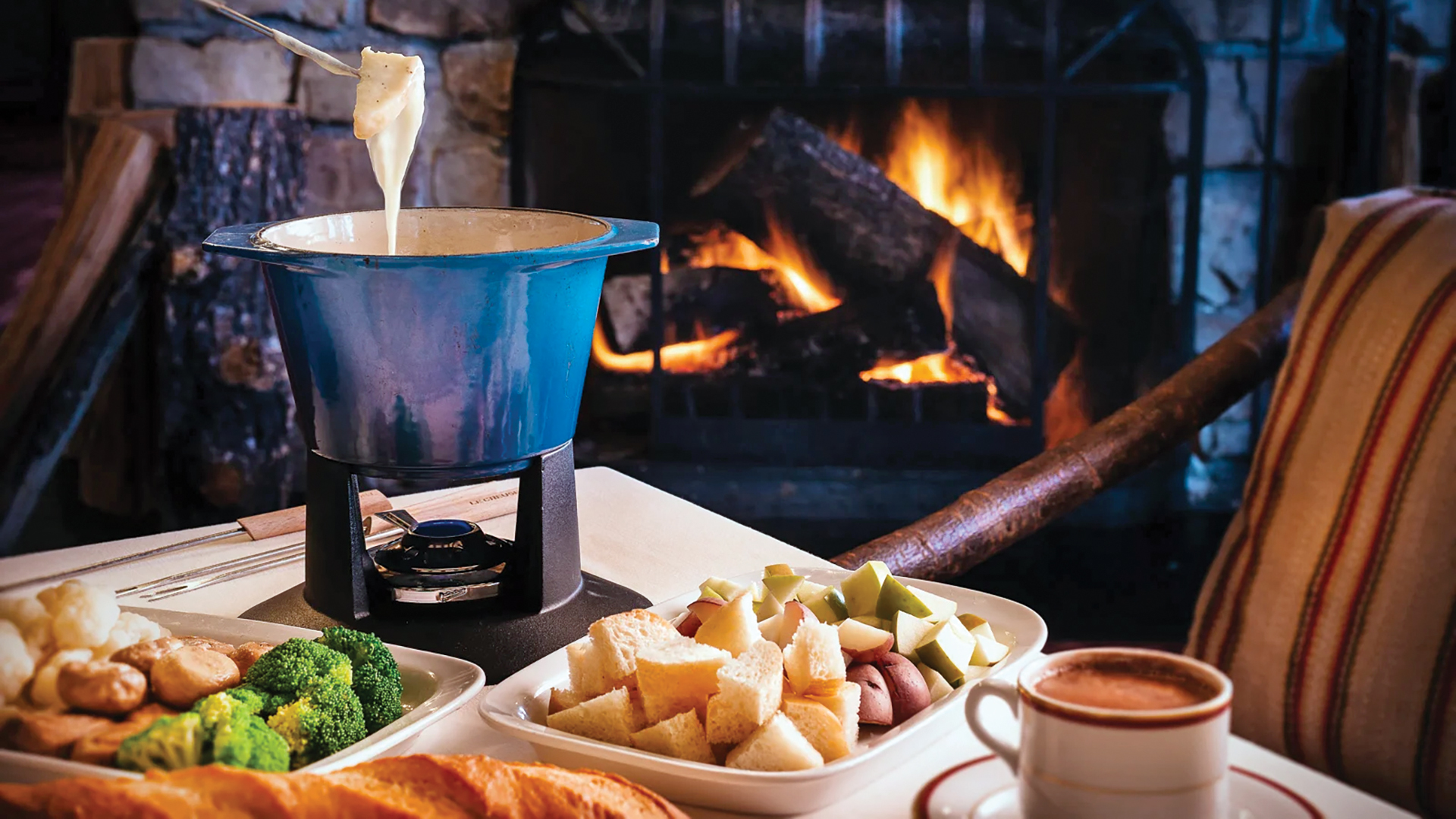
1 garlic clove, halved
1 pound Gruyère cheese, grated
½ pound Emmentaler cheese or other Swiss cheese, grated
1 cup dry white wine
1 tablespoon plus 1 teaspoon cornstarch
1 teaspoon fresh lemon juice
1 ½ tablespoons kirsch
Freshly ground pepper
Freshly grated nutmeg
preparation. Rub the inside of a cheese fondue pot or medium enameled cast-iron casserole with the garlic clove; discard the garlic. Combine the grated Gruyère and Emmentaler with the wine, cornstarch and lemon juice in the fondue pot and cook over moderate heat, stirring occasionally, until the cheeses begin to melt, about 5 minutes. Add the kirsch and a generous pinch each of pepper and nutmeg and cook, stirring gently, until creamy and smooth, about 10 minutes; don’t overcook the fondue or it will get stringy. Serve at once.
Savory Lamb Pops
With Rosemary and Garlic from The Grill at Knob Hill
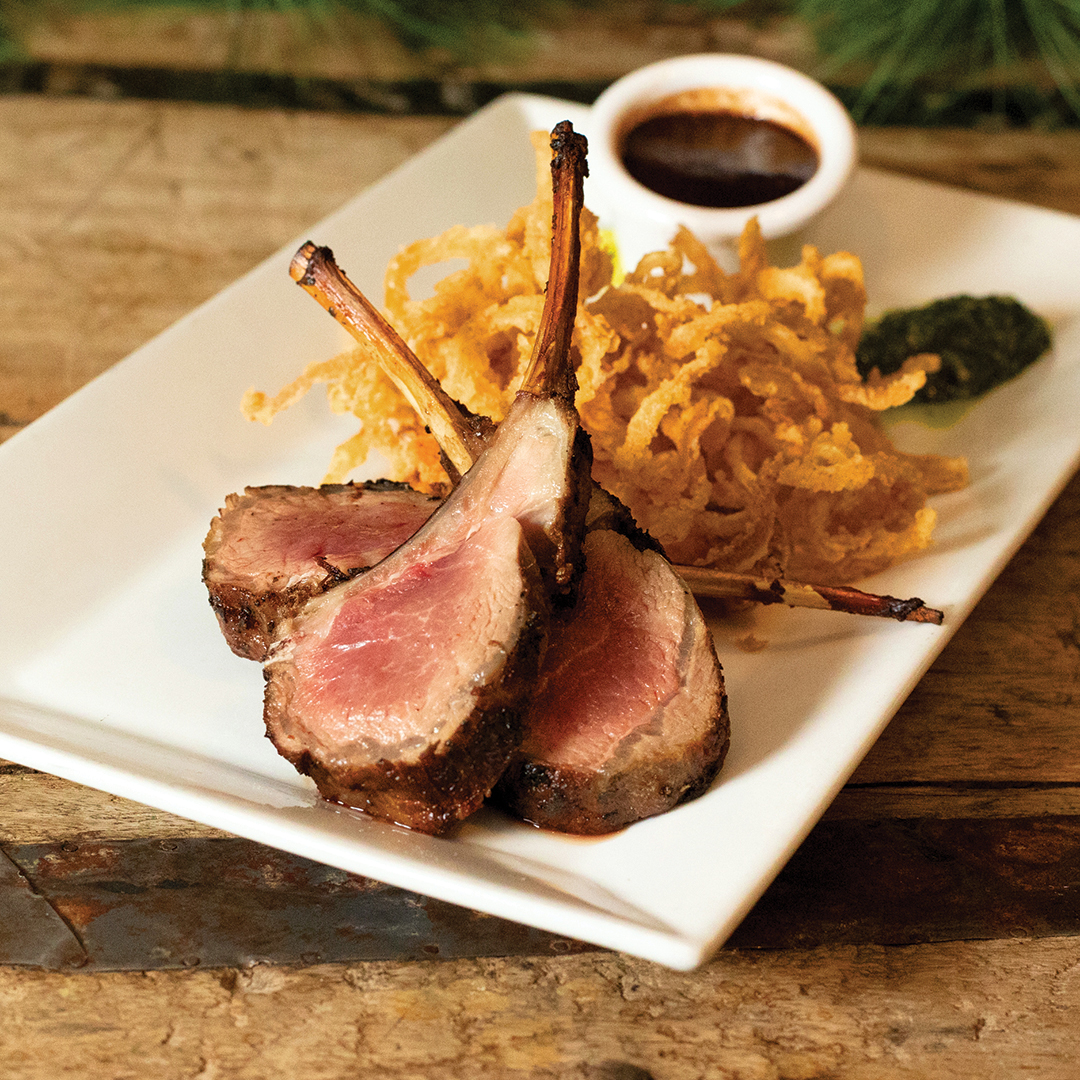
1 pound lamb rib chops
2 tablespoons minced fresh rosemary
2 teaspoons salt
1 teaspoon freshly ground black pepper
1 garlic clove, minced
4 tablespoons extra virgin olive oil, divided
advance preparation. Marinate the lamb chops for at least 30 minutes, or up to 24 hours. If you’re working with double rib chops, let them sit at room temperature 30 to 45 minutes before cooking; single rib chops can be kept refrigerated until time to cook. The marinade in this recipe includes fresh rosemary, salt and pepper, garlic, and olive oil. You could easily substitute other herbs or seasonings if you’d like, such as thyme or herbes de Provence.
preparation. Marinate the lamb chops in a mixture of herbs, garlic, olive oil, salt, and pepper. Sear the chops on high heat on the stovetop until browned on both sides. If you have thick double-rib chops and you would like them more well done, cover the pan, lower the heat to warm, or put them in the oven for a few minutes. Rest the lamb chops for 3 to 5 minutes before serving.
A lamb chop is such a lovely tender cut of meat, take care not to overcook it. Lamb is best eaten pink, from rare to medium. Overcooking tender lamb chops can result in dry, less-than-tender meat. That said, if you have eaters who prefer their meat more well done, you can always cook it longer.
Since rib chops are so small, and cook so quickly, checking for internal temperature of single rib chops with a thermometer can be impractical. Use the finger test to check the doneness of the chops. If you have an instant read thermometer and want to check thicker chops, aim for 125°F for rare, 135°F medium-rare, and 140°F medium.


